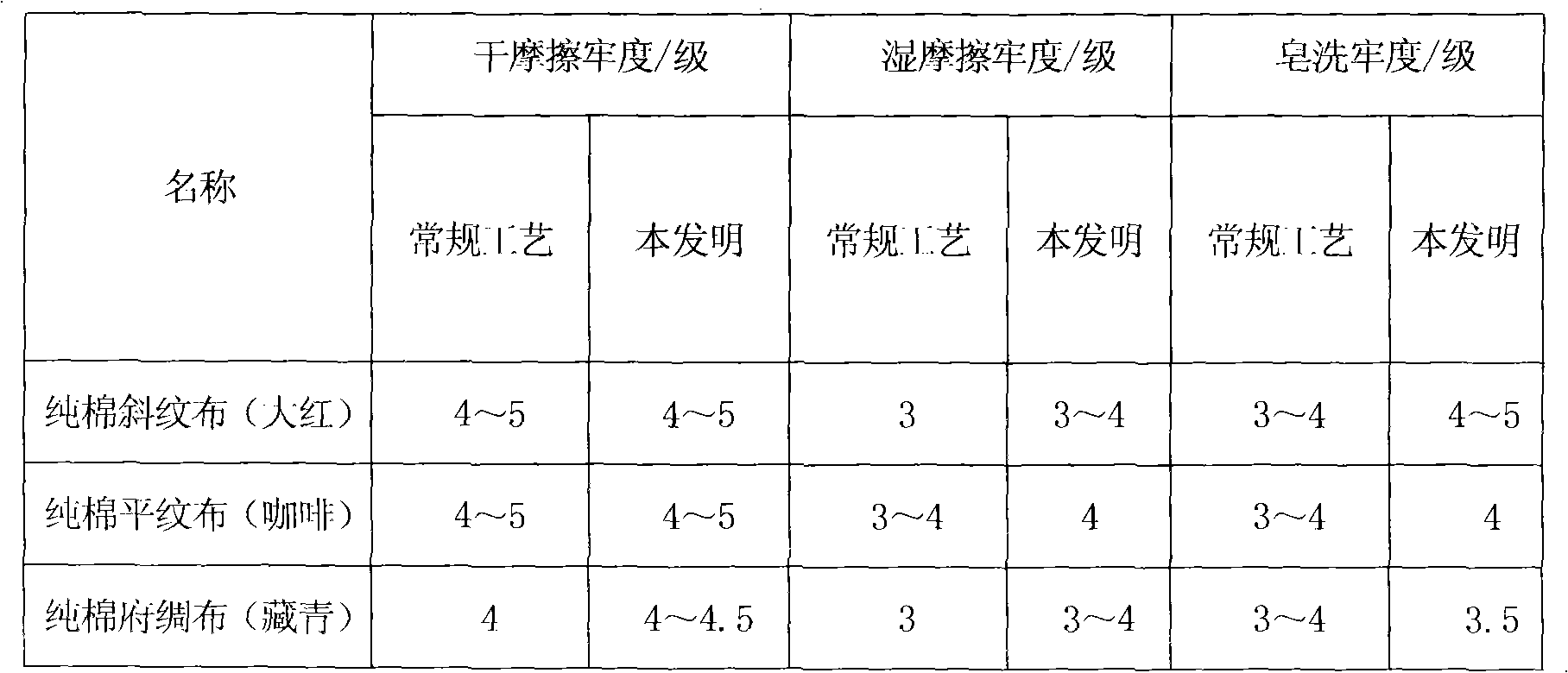Washing technology of active dye detergent
A technology of reactive dyes and detergents, used in dry cleaning fiber products, textiles and papermaking, etc., can solve the problems of products that do not meet the requirements of wet rubbing fastness, and the floating color is not clean, and the washing process is simple and easy to implement. , good cleaning effect, wide application prospects
- Summary
- Abstract
- Description
- Claims
- Application Information
AI Technical Summary
Problems solved by technology
Method used
Image
Examples
Embodiment 1
[0034] Embodiment 1: one, the preparation of detergent:
[0035] 1) Preparation of aqueous phase solution: at first dissolving chitosan with a degree of deacetylation of 96% in the acetic acid solution of 2% by volume to obtain a chitosan solution with a mass percent concentration of 0.5%, then dissolving gelatin in water Obtaining a gelatin solution with a mass concentration of 3%;
[0036] By chitosan: gelatin is 1: 1 mass ratio chitosan solution and gelatin solution are mixed to obtain chitosan / gelatin solution;
[0037] 2) Emulsion preparation: add emulsifier to liquid paraffin to obtain a mixed solution of liquid paraffin and emulsifier by volume ratio of emulsifier: liquid paraffin=1:300, said emulsifier is Span 80 and Tween 80, wherein The volume ratio of Span 80 and Tween 80 is 1: 1; then chitosan / gelatin solution is added to the mixed solution of liquid paraffin and emulsifier by the volume ratio of chitosan / gelatin solution: liquid paraffin=1:4 medium, emulsified a...
Embodiment 2
[0049] Embodiment 2: one, the preparation of detergent:
[0050] 1) Preparation of aqueous phase solution: at first dissolving chitosan with a degree of deacetylation of 94% in acetic acid solution of 3% by volume to obtain a chitosan solution with a mass percent concentration of 1%, then dissolving gelatin in water Obtaining a gelatin solution with a mass concentration of 4%;
[0051] By chitosan: gelatin is the mass ratio of 2: 1 that chitosan solution and gelatin solution are mixed to obtain chitosan / gelatin solution;
[0052] 2) Emulsion preparation: add emulsifier to liquid paraffin to obtain a mixed solution of liquid paraffin and emulsifier by volume ratio of emulsifier: liquid paraffin=1:150, said emulsifier is Span 80 and Tween 80, wherein The volume ratio of Span 80 and Tween 80 is 2: 1; then chitosan / gelatin solution is added to the mixed solution of liquid paraffin and emulsifier by the volume ratio of chitosan / gelatin solution: liquid paraffin=1:5 , emulsified a...
Embodiment 3
[0064] Embodiment 3: one, the preparation of detergent:
[0065] 1) Preparation of aqueous phase solution: at first dissolving chitosan with a degree of deacetylation of 92% in acetic acid solution of 4% by volume to obtain a chitosan solution with a mass percentage concentration of 2%, then dissolving gelatin in water Obtaining a gelatin solution with a mass concentration of 6%;
[0066] By chitosan: gelatin is the mass ratio of 3: 1 that chitosan solution and gelatin solution are mixed to obtain chitosan / gelatin solution;
[0067] 2) Emulsion preparation: add emulsifier to liquid paraffin to obtain a mixed solution of liquid paraffin and emulsifier by volume ratio of emulsifier: liquid paraffin=1:200, said emulsifier is Span 80 and Tween 80, wherein The volume ratio of Span 80 and Tween 80 is 4: 1; then chitosan / gelatin solution is added to the mixed solution of liquid paraffin and emulsifier by the volume ratio of chitosan / gelatin solution: liquid paraffin=1:6 medium, emu...
PUM
 Login to View More
Login to View More Abstract
Description
Claims
Application Information
 Login to View More
Login to View More - R&D
- Intellectual Property
- Life Sciences
- Materials
- Tech Scout
- Unparalleled Data Quality
- Higher Quality Content
- 60% Fewer Hallucinations
Browse by: Latest US Patents, China's latest patents, Technical Efficacy Thesaurus, Application Domain, Technology Topic, Popular Technical Reports.
© 2025 PatSnap. All rights reserved.Legal|Privacy policy|Modern Slavery Act Transparency Statement|Sitemap|About US| Contact US: help@patsnap.com

